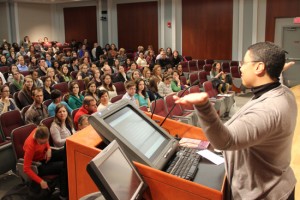Is Pornography a Public Health Issue? SPH Forum Considers Both Sides

In Catharine MacKinnon’s 1993 treatise Only Words, the feminist scholar writes that “the law of equality and the law of freedom of speech are on a collision course in this country.”
This semester, students at the School of Public Health are examining that collision through an unusual lens—not through the study of law or human rights, but through a lesson in hard-core pornography.
Four SPH faculty have introduced the subject of pornography into the curriculum in hopes of stirring debate around issues of public health. Does pornography shape the way adolescents think about their sexuality? Does it fuel sexual violence? Does it intentionally degrade women?
On Feb. 10 more than 150 public health students crammed into the Medical Campus Bakst Auditorium to view a documentary about the pornography industry, The Price of Pleasure: Pornography, Sexuality & Relationships, and hear from two leading experts on the topic: Gail Dines, a professor of sociology and women’s studies at Wheelock College, and Carol Queen, a sexologist and part owner of Good Vibrations, a sex merchandise company with stores in Brookline, Mass., and San Francisco.
The debate—with Dines taking the antiporn position and Queen the pro-porn—wound through issues of racism and rape, exploitation and sex education, poverty and patriarchy.
“It feels like this is what education should be like—tackling a hotly contested topic from different perspectives, including public health,” said Emily Rothman, an SPH associate professor of community health sciences, who organized the forum. “Pornography is so widely available now, in the Internet age, it’s naive to think that it isn’t having a profound impact on our culture, including the way we interact with each other.”
SPH Dean Robert Meenan (MED’72, GSM’89) acknowledged in his opening remarks that bringing students together to view and discuss a film that included scenes of hard-core pornography was not standard public health school fare. But, he noted, “Public health has to raise and deal with uncomfortable topics, and it has to push people into uncomfortable conversations.” Sex and debate, he said, are “perspectives that [fuel] the field of public health.”
Rothman, who teaches an SPH course in sexual violence, said she began thinking seriously about introducing pornography into the curriculum after seeing the The Price of Pleasure last year. The film explores the negative aspects of “gonzo” porn, in which the focus is on sexual acts—graphic and sometimes violent—not on a narrative story line.
“My first thought was, my students have to see this,” Rothman said. “I wanted us to explore the idea of whether pornography is a public health issue—and if it is, how do we come at it as practitioners?”

The forum brought Rothman’s class together with three other SPH classes that deal with sexuality, reproductive health, and adolescent health. The SPH faculty members teaching those classes–Renee Johnson, an assistant professor of community health sciences, Sophie Godley (SPH’15), a clinical assistant professor of community health sciences, and Lois McCloskey, an associate professor of community health sciences–said pornography crossed into public health in many areas, including risk behaviors, sexual exploitation, and gender roles and behavior. The four had discussed the issues as part of their course work in advance of the forum.
“The best evidence we have suggests that young people today are being exposed to pornography a lot,” said Johnson, who teaches a class on adolescent health. That exposure raises questions about whether pornography should be part of sex education, she said.
Students peppered Dines and Queen with questions about the impact and intent of pornography, including whether the porn industry had created a market for violent porn or whether violence in the culture had pushed porn to its gonzo extremes.
“I just don’t understand how you can support an industry that’s so violent towards women,” one student pressed Queen.
“Where is the line—a world with no porn?” another student asked Dines. “If we limit this type of speech, where do we draw the line?”
Dines said “body-punishing, brutal pornography” has become “the number one most profitable pornography,” and she argued that poverty, racism, and sexism drive the industry. “In an ideal world, they would have trouble finding women who would elect to do this” for employment, she said, adding that she views pornography as propaganda for a patriarchic social structure.
“Nothing delivers patriarchy to you like a bullet between the eyes like pornography,” she said.
Queen said gonzo porn is just one swath of the pornography landscape, and cautioned the students not to conflate violence with explicit sex. “The industry is more diverse” than what the film depicted, she said.
The two speakers clashed around the question of whether pornography is a trigger for sexual violence.
“What I know about sexual violence and rape, it isn’t about sex—it’s about violence,” Queen said. She doesn’t believe exposure to pornography “makes you do the things you see. It’s perfectly possible to see something and not imitate it.”
But Dines said it was wrong to assume that pornography plays no role in sexual violence. “Advertising has an effect on consumer behavior—we would all agree on that,” she said. “So does porn that involves violence and abuse. The bigger issue is, how is this imagery constructing men’s sexual identities?”
Rothman said research into the link between pornography and sexual violence is a new field, one she has started pursuing. A recent study she led found that young women who had seen pornography in the prior month were five times as likely as those who had not seen pornography to report having had a group-sex experience, coercive or consensual.
Godley, who teaches the SPH class Safer Sex in the City: From Science to Policy, which deals with research-based knowledge about sexuality and health, acknowledged that she was initially apprehensive about having her students see The Price of Pleasure.
But she was delighted, she said, to be part of an event that allowed for “a civil dialogue between people who disagree. That’s a rare thing in 2012—to actually have a productive discussion that moves us forward and gets us all thinking.”
In this video link, SPH faculty discuss whether pornography has become a growing public health issue. Video by Michael Saunders
This BU Today story was written by Lisa Chedekel. She can be reached at chedekel@bu.edu.